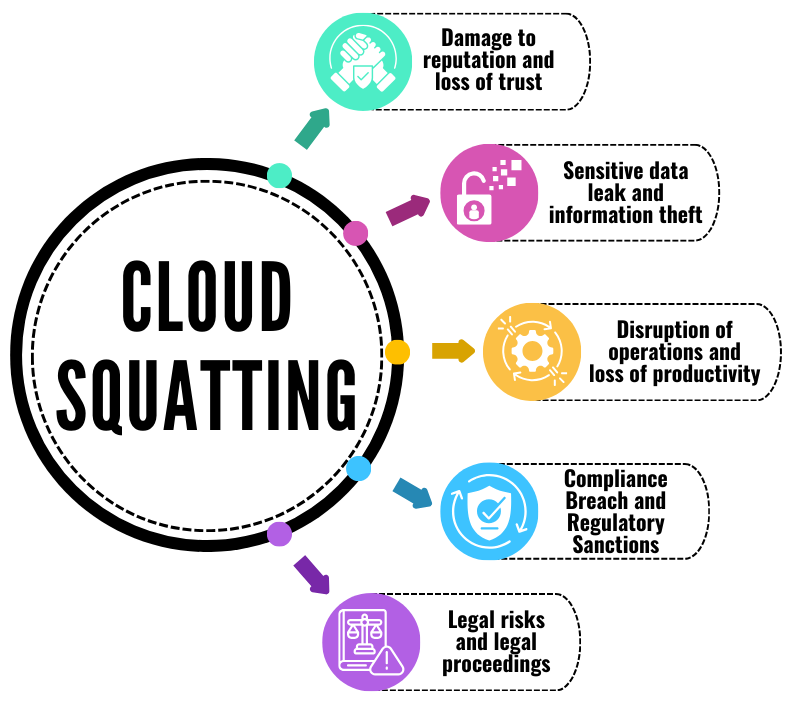Cloud Squatting
Cloud Squatting is a cyberattack that takes advantage of security vulnerabilities in the cloud computing environment. Cybercriminals target inactive cloud resources abandoned by organizations.
Cloud Squatting is a cyberattack that takes advantage of security vulnerabilities in the cloud computing environment. Its most common analogy is real estate “squatting,” where individuals illegally occupy vacant properties.
What is Cloud Squatting?
In cloud squatting, cybercriminals target inactive cloud resources abandoned by organizations.
These forgotten resources can be a goldmine for hackers because they often remain active even when no longer in use, creating vulnerable entry points.
How does Cloud Squatting work?
Cloud Squatting is carried out in several key steps which exploit security vulnerabilities in the cloud. Here’s how it works, outlining the risks and consequences:
1. Inattentive release of resources in the cloud
An organization uses a cloud computing service and allocates resources like storage, databases, or subdomains. Over time, these resources become obsolete or no longer needed.
However, sometimes removing these resources is done without sufficient attention to the associated configuration.
For example, the IT team simply deletes cloud storage, but forgets to clean up the Domain Name System (DNS) records that pointed to that storage.
2. Persistence of “orphan” records
This is when things become critical. Deleting cloud resources does not necessarily delete the records associated with them.
These “orphaned” recordings are floating in the cloud, still active and ready to be used. They can include domain names, entry points to databases or cloud applications.
These orphaned records are like backdoors left open in the system, waiting for a malicious actor to discover them.
3. Lurking Attackers and Exploration Techniques
Malicious individuals are actively searching for these forgotten records. They can use automated tools to scan the cloud at lightning speed, looking for vulnerable entry points.
These tools work a bit like robots searching the rubble of a construction site, looking for forgotten but usable materials.
4. Malicious exploitation with serious consequences
Once an attacker finds an orphaned record, they can abuse it in several ways, causing potentially serious damage:
Targeted phishing
The attacker can impersonate a legitimate service by using the orphaned subdomain to create a fraudulent website. This site will look genuine and trick users into entering confidential information such as login credentials or credit card information.
Imagine an orphan record linked to an online financial management service. An attacker could create a fake website that looks exactly like the legitimate site, and trick users into logging in and entering their banking credentials.
Malware distribution
The orphaned record could be used to host malware. If a user unwittingly accesses this type of booby-trapped website, their device could be infected with malware designed to steal data, spy on user activity, or take control of their device remotely.
What are the consequences of Cloud Squatting?
The consequences of Cloud Squatting can be serious for individuals and organizations. Here are some of the main threats:

Damage to reputation and loss of trust
When a fraudulent website impersonating a legitimate brand is created using an orphan subdomain, users who fall for the trap may provide their confidential information, such as login credentials or passwords. credit card information. The consequences are significant financial losses and damage to the reputation of the legitimate brand.
Sensitive data leak and information theft
Attackers can leverage squatted cloud resources to host malware that can infect user devices and steal sensitive data, such as personal information, financial data, or trade secrets. This can result in significant financial losses, breaches of confidentiality and reputational damage.
Disruption of operations and loss of productivity
Phishing attacks and malware delivered through Cloud Squatting can disrupt an organization’s operations, leading to downtime, lost productivity, and additional costs of repairing systems and dealing with the consequences of the attack.
Compliance Breach and Regulatory Sanctions
Cloud Squatting can lead to violations of data protection regulations, such as GDPR, if user data is compromised. Data compromise can result in significant fines, reputational damage and damage to customer trust.
Legal risks and legal proceedings
Organizations that fall victim to Cloud Squatting can be sued by customers whose data was compromised or who suffered financial losses due to an attack. This can result in significant legal costs and civil liability.
How to protect yourself from Cloud Squatting?
By taking a proactive approach and putting robust protection measures in place, you can significantly minimize your risks and protect your place in cyberspace.
1. Cloud hygiene
Clean tirelessly
Regularly eliminate obsolete cloud resources, such as unused storage, inactive databases, or forgotten subdomains. Don’t let these digital remains accumulate and become targets for attackers.
Meticulous configuration
When deleting resources, don’t just delete them. Be sure to clean up associated configurations as well, especially DNS records that might still point to the missing resources. These digital “orphans” are hidden treasures for malicious squatters.
Vigilant surveillance
Keep a close eye on your cloud resources, looking for suspicious activity or anomalies. Many cloud providers offer valuable monitoring tools to help you with this.
2. Cloud Security Services
Security Solutions
Deploy dedicated cloud security solutions to detect and block malicious intrusions into your cloud resources. These digital sentinels constitute an essential first line of defense.
Reputation monitoring
Protect your image by using web monitoring services that track fraudulent websites impersonating your organization. Early detection can limit the damage and save your reputation.
3. User awareness and accountability
Safety training
Educate and raise awareness among your employees about the dangers of Cloud Squatting and good online security practices. Empower them to identify phishing attempts and protect sensitive information.
Clear reporting procedures
Establish clear and accessible procedures for employees to report suspicious activity encountered while using cloud resources. This allows for a rapid and effective response to potential incidents.
4. Identity and Access Management (IAM)
Principle of least privilege
Grant users only the access they need to complete their tasks. Don’t let excessive privilege create exploitable security vulnerabilities.
Strong authentication
Require strong authentication, such as two-factor authentication (2FA), for all cloud access. Add an extra layer of security to repel intruders.
Regular access checks
Review and revoke user access regularly. Ensure that only authorized and active users have access to your cloud resources.
5. Incident response plan
Proactive planning
Develop a clear and detailed response plan to deal with Cloud Squatting incidents. Define roles, responsibilities and procedures to follow in the event of an attack.
Transparent communication
In the event of an incident, ensure clear and transparent communication with all relevant stakeholders. This allows for coordinated management and rapid mitigation of damage.
Regular testing and updates
Test and update your response plan regularly to ensure it remains effective in the face of ever-changing threats.
